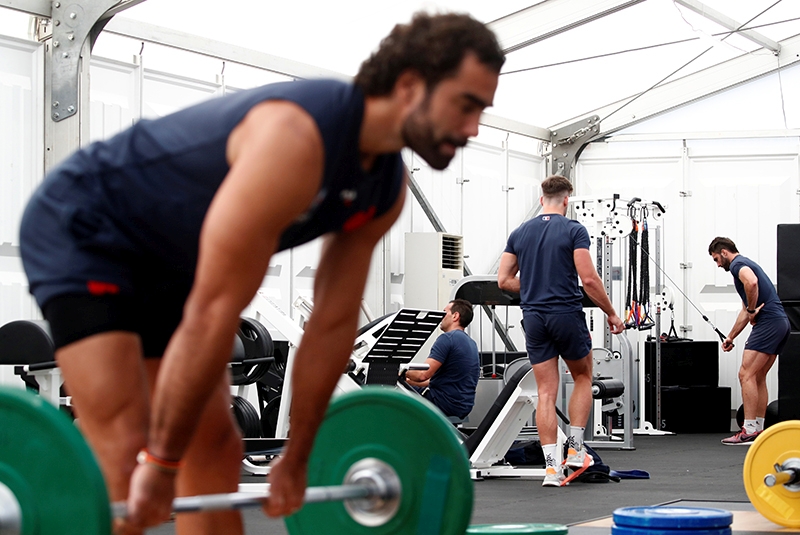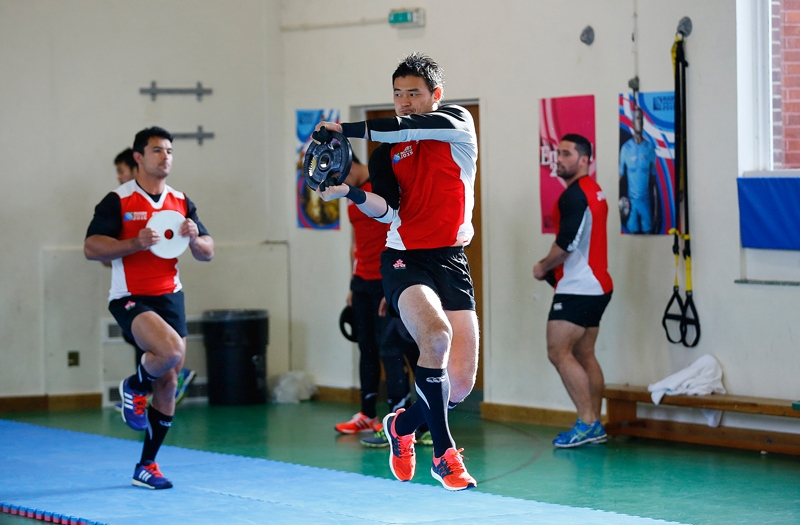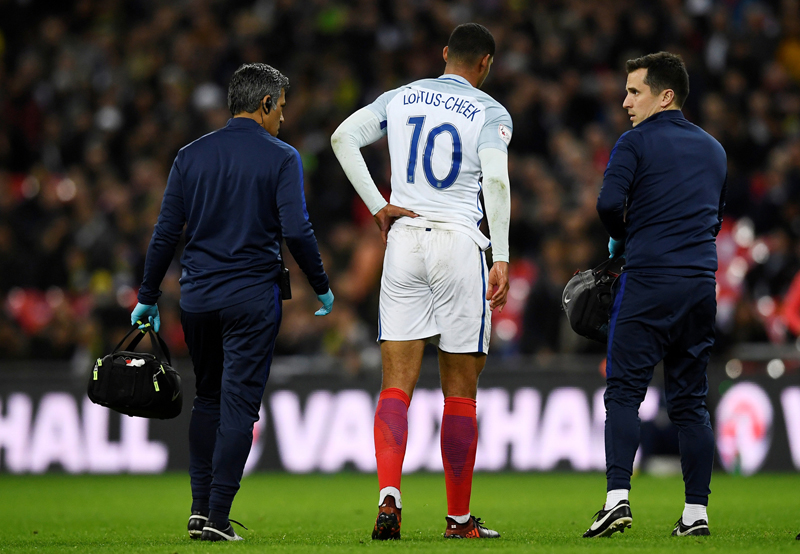You are viewing 1 of your 1 free articles. For unlimited access take a risk-free trial
A balanced approach to leg strength
Trevor Langford explains what your quadriceps to hamstring strength ratio is and why the right ratio is important for injury prevention

Knee injuries are common in athletes, and effective strengthening programmes are often required to improve functional strength and stability. In particular, a deficit in hamstring muscle (rear of the thigh) strength compared to the quadriceps muscle (frontal thigh) is a precursor to lower extremity injuriesJ Sci Med Sport, 2008, Sep, 11, 5, 452–459. The aim of this article is to explain the importance of achieving balanced leg strength, and how to attain this during conditioning or rehabilitation after injury.
What is H/Q ratio?
The hamstring to quadriceps ratio abbreviated H/Q ratio refers to the ratio of strength between the two muscle groups. Let’s take some examples to try and explain what this involves. During the kicking action in football, as the ball is struck,the hamstring muscles are required to lengthen under load which is referred to as eccentric muscle action (see figure 1). At the same moment, the quadriceps muscles are required to shorten, which is referred to as a concentric muscle action (figure 1).
Figure 1: Definition of muscle actions

Now consider a rower. During the rowing action as the seat moves backwards, the hamstrings are lengthening as the quadriceps shorten (and vice-versa as the seat moves forwards). A further example is during cycling; while the pedal is being pushed through the downward phase, the quadriceps shorten as the hamstrings lengthen.
During the upward phase, the hamstrings are shortening while the quadriceps are lengthening. Due to this reciprocal relationship between the hamstrings and quadriceps, it turns out that the ratio of hamstring to quadriceps strength is important, affecting the function of the knee joint and the risk of injury.
Measuring H/Q ratio
Measuring H/Q ratios is most commonly done by using an isokinetic dynamometer (see later). These are very expensive pieces of equipment used in high performance facilities, which provide a vast amount of data with regards to forces applied at certain speeds and at different joint angles.
An athlete may be fortunate enough to gain access to one of these when rehabilitating a knee or thigh injury. If this option isn’t available, other means such as a leg extension and seated curl machines used in a gym setting can also be used to determine individual muscle strength (see figure 2). This can be done using a 1 rep maximum (1RM) test, which is the maximum weight that can be lifted under control, through the full range of movement, and without compromising technique. It’s not possible using these machines to obtain the same data as an isokinetic dynamometer but it does allow for any strength deficits to be identified.
Figure 2: Measuring H/Q ratio


What is a normal H/Q ratio?
One of the key questions is what is considered as a desirable H/Q ratio for a healthy knee. The consensus of research suggests that a 50-80% (ratio of 0.5-0.8) is acceptable, but greater than 60% is desirablePhys Thera in Sport, 2010, 11, 12–17. To help explain, this is the percentage of strength of the hamstring muscles in comparison to the strength of the quadriceps. So for example, if this ratio was 80%, the hamstrings would be able to lift a maximum of 80kg in comparison to a 100kg quadriceps maximum.
This matters because research also has shown that higher H/Q ratios of around 100% (ie hamstring strength the same as the quadriceps throughout full range of movement) may help to reduce the risk of a hamstring strainJ of Human Kinetics, 2012, 33, 63-71. A ratio of 100% also reduces the risk of the knee partially dislocating in those who have been unfortunate enough to suffer a previous anterior cruciate ligament (ACL) injuryJ Athl Train. 2012, Aug, 47, 4, 396–405.
The use of an isokinetic dynamometer is helpful in this context because it can provide far more specific details such as strength and force capacity of hamstrings and quadriceps at different knee joint angles. It is particularly productive during pre-season training or at a medical to provide data of an athlete’s normal H/Q ratio, so in the event of a knee injury previous ratios can be attained.
Figure 3: Dynamometer for evaluating H/Q ratio

Anterior cruciate ligament (ACL) rehabilitation
The ACL is frequently injured in sportsmen and women. The hamstring muscles function to stabilise the knee and support the ACL by preventing the shin bone from shifting forwards as the knee straightens. Therefore, during a rapid extension action such as kicking, the hamstrings are acting eccentrically (muscle lengthening) to help prevent the shin bone from shifting forwards, placing excessive loading onto the ACLJ of Human Kinetics, 2012, 33, 63-71. Figure 4 illustrates the concentric (muscle shortening) action of the quadriceps during a kicking action in comparison to the eccentric (muscle lengthening) action of the hamstrings. You can hopefully see why ACL rehabilitation needs to promote hamstring strength and provide the knee joint with additional control.
Figure 4: Hamstring strength to protect the ACL (side view of knee)
Related Files
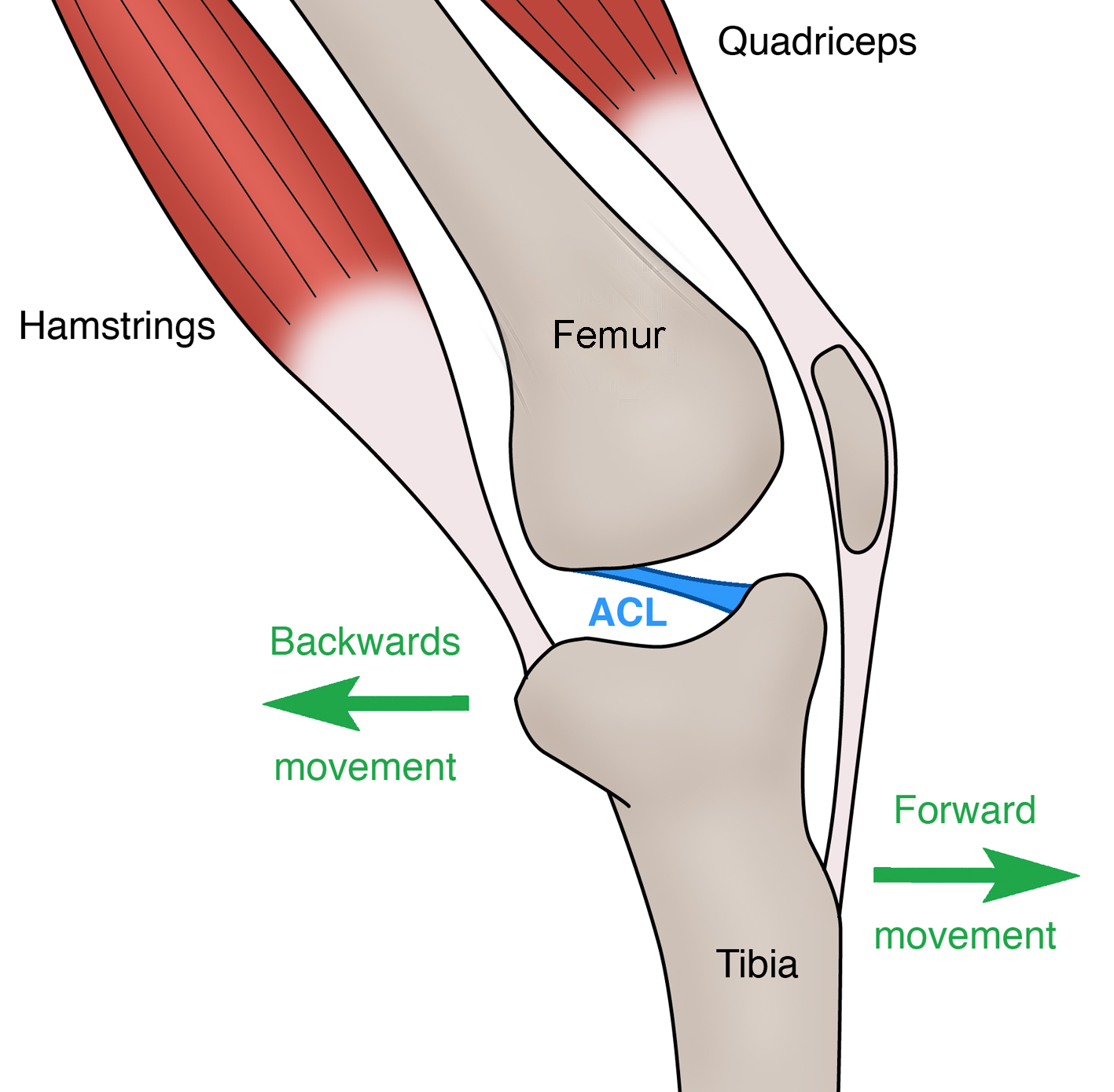
Exercise therapy
Exercises that produce a dominant quadriceps activation can increase the shearing-type forces on the knee joint, particularly during movements where the leg is extended rapidly (this is why strong hamstring muscles are so important to balance the knee)J Athl Train. 2012, Aug, 47, 4, 396–405. Following a knee injury, it is therefore essential to promote exercises that provide simultaneous activity of both the hamstrings and quadriceps – often referred to as a co-contraction. In particular, it’s essential to commence co-contraction exercises early in the rehabilitative phase. This encourages effective hamstring and quadriceps muscle control during the latter stages, ready for a return to sport.
A really simple exercise to begin soon after knee injury or surgery is in sitting with legs straight on a bed, and with a towel under your knee (see figure 5). Contract your buttock muscle in a stationary position and then push the back of the knee down into the towel to engage your hamstrings before straightening your knee to fully activate the quadriceps. Hold for five seconds before releasing in the reverse order. This is a great exercise to engage the quadriceps and hamstrings prior to moving onto weight bearing exercises.
Figure 5: Buttock, hamstring and quadriceps co-contraction exercise

Exercises that work multiple joints and muscles at the same time are effective for improving the muscle balance around the knee (see figure 6). These exercises are referred to ‘closed kinetic chain’ exercises, where the foot is engaged with a fixed surface. By contrast the leg extension and seated leg curl performed in the gym are ‘open kinetic chain’ exercises, where the foot is not engaged with a fixed surface. While these machine exercises are useful tools for assessing H/Q ratio, they don’t promote co-contraction of both the hamstrings and quadricepsJ Athl Train. 2012, Aug, 47, 4, 396–405. Related to this, a useful tip for the exercises in figure 6 is to ensure that your heel is placed firmly on the floor rather than the weight being on the toes, which would increase activity of the quadriceps muscle.
Figure 6: Exercises for improving muscle strength balance around the knee

Figure 7: Hamstring exercises to increase hamstring muscle control
Swiss ball hamstring curls
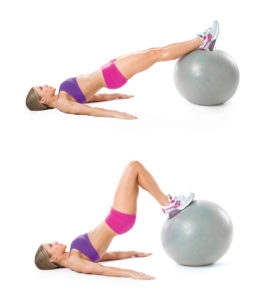
Nordic curls

To develop hamstring strength and endurance use these two exercises to improve hamstring muscle activity:
- The Swiss ball hamstring curl is great exercise for loading the hamstring muscles. This should be performed over a longer duration to improve muscle endurance at a slighter faster speed (but with control). This exercise incorporates the concentric and eccentric phases of the hamstring muscle activity. Aim to perform 15 – 20 repetitions over 3-5 sets, building up to this if you find it demanding. If you experience any lower-back pain during this exercise, pause between repetitions before lifting your hips again and ensure that the buttock muscles are engaged with the exercise.
- The Nordic curl is an excellent exercise to improve eccentric (muscle lengthening) strength and should be performed over 3-5 sets of 4-8 repetitions. When you first start this exercise you may find that the load is quite a lot for your hamstring muscles and therefore three sets of four repetitions is a great starting point. As you increase in strength aim to increase to five sets whilst progressively increasing towards eight repetitions in each set. Make sure the
Nordic curl is performed in a slow controlled manner working against gravity to load the hamstrings. At the end of each repetition just come onto all fours and lift up into the start position without loading the hamstrings and the lower back during the upward phase.
The Nordic curls and swiss ball hamstring curls challenge the hamstring muscles in different ways at varying speeds to improve the H/Q ratio. Although they aren’t functional exercises for kicking or running they do isolate the hamstrings ready for more functional strength exercises.
Key learning points
- It is essential to restore muscle balance in the hamstring and quadriceps muscles following a knee or thigh injury. This can not only provide functional stability to the knee to prevent further injury, but also help to optimise performance of the thigh muscles.
- A ratio of 0.5 or 50% of hamstring strength to quadriceps is sufficient for daily living activities, but for athletic activity, the ratio required is closer to 0.8 or 80% muscle activity.
- From an ACL injury perspective, it is desirable to obtain a H/Q ratio closer to 100% - ie equal hamstring and quadriceps strength.
Newsletter Sign Up
Testimonials
Dr. Alexandra Fandetti-Robin, Back & Body Chiropractic
Elspeth Cowell MSCh DpodM SRCh HCPC reg
William Hunter, Nuffield Health
Newsletter Sign Up
Coaches Testimonials
Dr. Alexandra Fandetti-Robin, Back & Body Chiropractic
Elspeth Cowell MSCh DpodM SRCh HCPC reg
William Hunter, Nuffield Health
Keep up with latest sports science research and apply it to maximize performance
Today you have the chance to join a group of athletes, and sports coaches/trainers who all have something special in common...
They use the latest research to improve performance for themselves and their clients - both athletes and sports teams - with help from global specialists in the fields of sports science, sports medicine and sports psychology.
They do this by reading Sports Performance Bulletin, an easy-to-digest but serious-minded journal dedicated to high performance sports. SPB offers a wealth of information and insight into the latest research, in an easily-accessible and understood format, along with a wealth of practical recommendations.
*includes 3 coaching manuals
Get Inspired
All the latest techniques and approaches
Sports Performance Bulletin helps dedicated endurance athletes improve their performance. Sense-checking the latest sports science research, and sourcing evidence and case studies to support findings, Sports Performance Bulletin turns proven insights into easily digestible practical advice. Supporting athletes, coaches and professionals who wish to ensure their guidance and programmes are kept right up to date and based on credible science.
